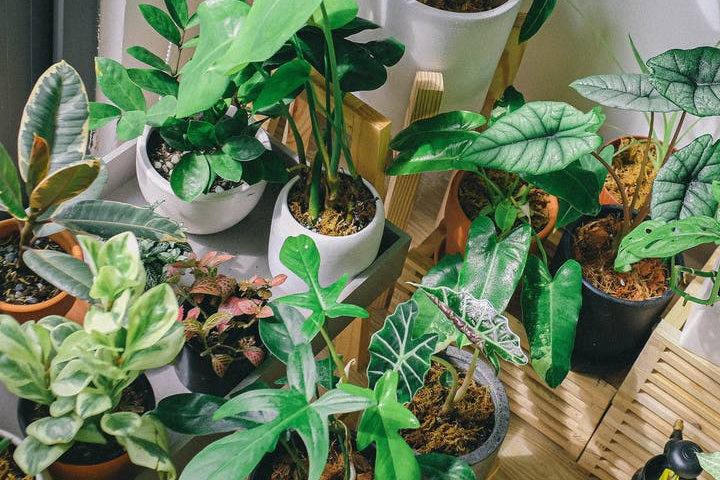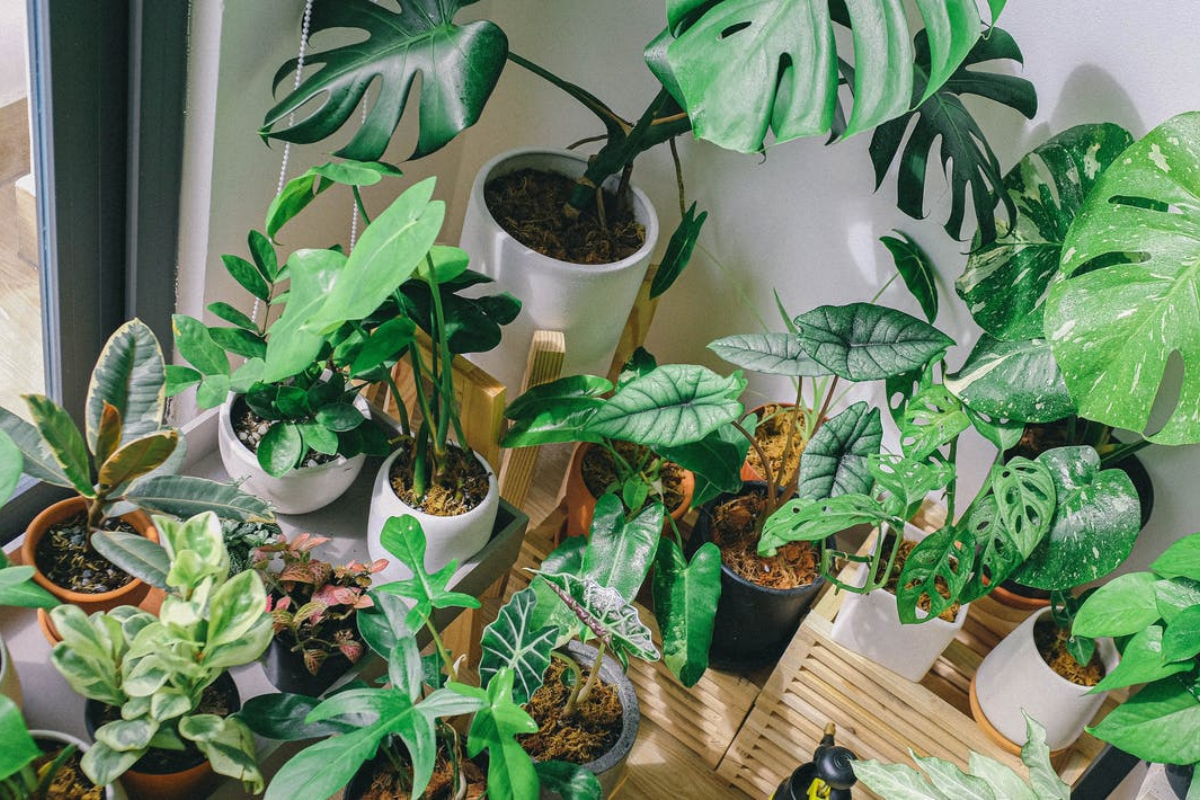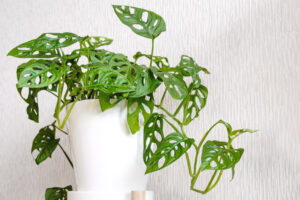
Table of Contents
Introduction to Monstera Esqueleto
Monstera is a tropical vine that originates from the tropical regions of the Americas. There are several types of the Monstera plant. They are usually characterized by fenestrations, which are natural holes in the plant’s large leaves.
The primary reason behind these fenestrations is to acquire the maximum amount of sunlight in a dense canopy.
The Monstera is a genus of the 49 flowering plant species belonging to the arum family, Araceae. Out of these, only a few Monstera types are available as houseplants. The Monstera Esqueleto, also referred to as Monstera Epipremnoides, is a rare and unique indoor plant that will perk up the look of your home, if you manage to properly take care of it.
Features
The Monstera esqueleto is recognized by its large leaves, often bigger than the other types of monstera plants. They can grow up to 2 feet long!
The leaves are a light green color, and exhibit a leathery texture. While all the monstera plants are recognized by fenestrations, the holes in the Monstera esqueleto tend to be bigger, occupying most of the leaves, especially in the juvenile stage. These holes are irregular; some are very big while others are smaller.
As the plant matures, these incisions extend to the borders. The leaves then start to take on a pinnafied appearance, like that of palm tree leaves. While the leaves themselves are large, the plant’s height is short as it typically grows to 1 foot. The Monstera esqueleto rarely flowers, especially indoors. They might bloom in their natural habitat though.
Where Does Monstera Esqueleto Come From?
The Monstera esqueleto, like all monstera species, is a tropical plant. It belongs to the Araceae family, and originates from the cloud forests of Costa Rica.
It is possible to grow the Monstera esqueleto indoors, but you would have to replicate its natural environment, which consists of mild temperature, humidity, and lots of rainfall. Due to its place of birth, this plant has huge fenestrations to survive heavy rainfall and wind.
How do You Identify Monstera Esqueleto?
It’s easy to confuse the types of plants in the Monstera genus. Monstera adansonii and Monstera esqueleto are two of the most popular monstera plants, and they look quite similar at first glance. It’s easy to confuse the two, but it is still possible to tell them apart and identify Monstera esqueleto.
Let’s look at the primary differences between Monstera adansonii and Monstera esqueleto.
Difference in Origin
Both the plants belong to the Araceae plant family, but their places of origin are different.
The Monstera adansonii is widespread in South America and Central America. It is found in certain parts of Southern Mexico and the West Indies. However, the Monstera esqueleto grows in the rainforests of Costa Rica, where it receives and enjoys plenty of rainfall.
Leaf Color
While they may look strikingly familiar at once, you’ll be able to see the color difference between the two upon closer inspection. The Monstera esqueleto is a lighter shade of green as compared to the Monstera adansonii.
The former may also have shades of yellow, but the latter is dark green with a glossy finish. However, the foliage of Monstera esqueleto is still quite beautiful, and will make a pleasant addition to any home.
Leaf Shape and Texture
In addition to the color, the leaf textures of the two plants differ as well. Monstera esqueleto has a distinctly more leathery texture as compared to the Monstera adansonii. The latter has smoother leaves, and a glossier finish.
The leaf shape is more or less the same. The leaves of both the plants are oval, often heart-shaped as well. The perforations make it easier to distinguish between the two based on appearance.
Plant’s Size
Perhaps the most striking difference between the two plants is the leaf size. Monstera esqueleto has significantly bigger leaves than the Monstera adansonii.
The esqueleto’s leaves can grow up to 20 inches long and 12 inches wide while adansonii’s leaves are smaller in comparison, about 15 inches long and about 9 inches wide.
The Monstera esqueleto can develop vines that are up to 2 feet long. The large leaves of the esqueleto allow the plant to survive extreme climatic conditions like heavy wind and rainfall.
Flower Difference
Monstera esqueleto rarely ever flowers indoors, and this is a more common occurrence in its natural habitat. If you spot yellowish-white flowers on the Monstera plant, then chances are it’s adansonii.
When exposed to the proper conditions, these flowers will then bloom into fruit. You can then eat this fruit, which has a sweet, pineapple-like taste.
Fenestration Pattern
The Monstera genus is known for its unique fenestration pattern. But the pattern isn’t the same among all the Monstera types, and there are clear differences between the Monstera esqueleto and adansonii.
Esqueleto has larger leaves with significantly bigger incisions than the other types. Perforations can be seen in both, but the esqueleto has larger and more frequent holes, especially in mature plants. These holes start at the center of the leaf and extend to the tip. As a result, the leaves of the esqueleto are often incomplete, almost in a pinnafied pattern, resembling palm tree leaves.
The fenestrated pattern of the adansonii is characterized by tiny holes, significantly smaller in size. The holes are also thinner, almost resembling a narrow circle. The size of these holes isn’t homogenous but they are consistently flat.
Growth Rate
Both the Monstera species have a vining growth pattern, but the adansonii tends to trail more than the esqueleto. The adansonii has a higher growth rate compared to the esqueleto and provides many smaller vines in a short span of time.
It is touted as the aggressive viner among the Monstera genus, as it is able to reach a height of 2 feet annually. Adansonii has the highest growth rate from April to October.
While the adansonii tends to climb, the esqueleto is more of a ground creeper. It is a hemiepiphyte as a juvenile and an epiphyte when it matures. If you are looking for a Monstera plant to display, the adansonii looks better hanging over a trellis or over a basket.
How to Care for Monstera Esqueleto?
The care instructions for most Monstera plants are similar. They all require less light, moderate temperatures, and almost any humidity conditions to grow and thrive indoors.
If you have your heart set on the Monstera esqueleto, you should know that it is a lot less forgiving than other varieties like the easy-going Monstera adansonii and the resilient Monstera deliciosa.
It requires exact conditions to survive and grow, especially when it comes to humidity. If kept in the right environment, the Monstera esqueleto will prove to be a rewarding plant. Let’s look at the Monstera esqueleto care guide.
Soil and potting
Monstera esqueleto has more sensitive roots that can rot, so it requires highly specific soil conditions. It needs excellent drainage to avoid overwatering.
Ideally, the esqueleto plant should have a pot that is 2-3 inches larger than its root ball. This allows it enough space to grow without holding onto more water than it needs.
The Monstera esqueleto needs high-quality soil that should be well-aerated, evenly moist, permeable, and not overly soggy. The ideal PH of the soil is between 5 and 7. Avoid using poor quality, wet soil that may damage the plant’s roots.
Light
The Monstera esqueleto grows in Costa Rica’s dense rainforest, where the heavy canopy protects it from too much direct sunlight. As a result, this plant needs bright, but indirect light to thrive and grow.
To imitate this picky plant’s natural habitat, you need to place it somewhere it will get lots of filtered light. Be very careful that the plant does not get direct sunlight, especially after 10 am.
Ideally, you should place it in a spot close to an east-facing window, or one that is just a few steps away from the west or southern-facing window. If you notice that the Monstera esqueleto’s leaves are drying out, it may be an indication that it’s receiving too much light.
Watering
Just like other Monstera plants, esqueleto also needs moderately moist soil. Ideally, you should water the plant when the top 2 inches of the soil feel dry to touch. You should invest in a well-draining soil to prevent any issues.
It is best to water the plant once a week, as overwatering can prove counterproductive. The soil should be barely damp before you water it again. You can water the Monstera esqueleto from the top or from the bottom.
Bottom watering is a better option as it helps mitigate the risk of overwatering.
Temperature
When deciding the ideal temperature for the Monstera esqueleto, you should consider the tropical rainforest conditions.
The plant will thrive in temperatures between a range of 70 and 80 degrees Fahrenheit (21 to 27 degrees Celsius). While the high 60s may be acceptable, anything above 85 degrees or below 65 can be harmful to the plant.
Humidity
You should be very careful when it comes to humidity levels. Monstera esqueleto loves high humidity, so make sure it has plenty. It is vital if you want to ensure the leaves are healthy. The plant would require high humidity levels of 80% to 100%. If humidity levels are low in your house, you should consider setting up a humidifier near the plant.
Alternatively, you can set the plant in a steamy bathroom as it mimics the humidity levels of the Costa Rican rainforest, where the plant originates. If the plant’s leaves appear dry and crisp, this means it needs more humidity.
Fertilizer
The Monstera esqueleto needs a balance of nutrients to survive and grow. It is these nutrients that will produce the large leaves and the strong stems.
While the plant needs a nutrient boost from fertilizer, too much of it can result in fertilizer burn. It would be best to use fertilizer sparingly.
Use a gentle, diluted fertilizer 3 times a year, and make sure you apply it at a safe distance from the base of the Monstera esqueleto. You should consider buying plant food that is specifically made to suit this plant’s needs.
Pest and Diseases to Look Out For
Pests don’t usually affect the Monstera esqueleto unless the plant lives outdoors. However, this doesn’t mean they are totally immune to pests.
Here are the following diseases and pests that most commonly affect the Monstera esqueleto.
Yellow/Discoloration of Leaves
This is most often caused by an excessive amount of sunlight or water. If you notice the plant’s leaves turning yellow or showing discoloration in general, it’s time to change the water and soil, and ensure it is not receiving too much direct sunlight.
In such an instance, you should cut the yellow leaves when they turn dry.
Root Rot
The roots would rot if the plant is being overwatered. You would notice root rot by the plant’s distorted, yellow leaves and a mushy stem base. You may also notice brown or black patches on the roots.
To cure root rot, you must repot the plant. Make sure you get rid of the previous soil mix as that is most likely the cause of the problem.
Brow Edges
If you notice that the plant’s edges have turned brown and crisp, it may be indicative of poor, low level humidity or lack of water. It could also be caused by sunburn.
Make sure the light, watering, and humidity are correct to sort out this problem.
Curling Leaves
Low humidity and lack of water may cause the plant to droop and curl. This would be noticeable as the leaves will start to protrude inside.
To prevent this, make sure there is plenty of humidity, up to 80% at least and the plant receives water at least once a week or when the soil tip feels too dry.
When Should You Repot Monstera Esqueleto?
If you want to know the best time to repot the Monstera esqueleto, you need to closely monitor the soil. If it feels the roots are popping out, the roots start growing along the pot’s edges and the growth has slowed down, it may be time to repot the plant.
As a general rule, you should repot the Monstera esqueleto every year or two.
How Do You Repot Monstera Esqueleto?
In order to repot the Monstera esqueleto, you need to follow these steps:
- Tip the pot towards one side to unpot the plant
- Gently force the plant out without pulling on the stems
- Place a few handfuls of the soil in the new pot</li
- Put the plant on top of this
- Fill the edges with the potting mix
- Water the plant and top it off with some more of the potting mix
If you want a video tutorial, you can visit this link to see how to expertly repot the Monstera esqueleto.
Propagation of Monstera Esqueleto
Here are the easiest ways to propagate the Monstera esqueleto.
Separating
Unpot the Monstera and separate the plant into two smaller plants, untangling the root balls. Place these two plants into different plants to have several new baby plants. It’s that simple!
Stem Cutting
Locate a section that has fresh and healthy leaves. Now spot the node, which is a small bump on the stem which is on the opposite side of the leaf. Use shares or scissors to cut just below the node so that it is a part of the cutting.
Don’t forget this step as the node will bloom into the root! Now place this cutting into a glass with clean water and some propagation promoter. Place this in a bright place and water regularly. In just a few weeks, you will start to see roots forming.
Is Pruning of Monstera Esqueleto Necessary?
The ideal time to prune the Monstera esqueleto is in spring. It is recommended that you prune it only when the plant starts to become wild.
Pruning will then help get rid of any dead and damaged leaves.
Monstera Esqueleto Buying Guide
The Monstera esqueleto is a unique and rare plant that will really test your indoor gardening skills. Since it is an unusual tropical plant, it is quite costly to procure. Its maintenance isn’t that simple, but with the proper care, it will thrive.
If you want to guarantee the growth of the Monstera esqueleto, you need to be careful that you choose a reliable seller in order to get your hands on a healthy plant.
Since this is an expensive investment, make sure you choose the right product. Locating a reliable seller may take some time and research.
How to Pick a Healthy Monstera
Here are a few signs of a healthy Monstera esqueleto:
- Light green, upright leaves
- Healthy, glossy foliage
- No signs of pest infestation
- No brown, yellow or discolored edges
- Large leaves with enough fenestration from the center to the edges
- No signs of curling leaves
How Much Does a Monstera Esqueleto Cost?
While the Monstera esqueleto is not as rare or expensive as other species like the Monstera Obliqua, it can still be challenging to find.
Therefore, it is important to select a reliable seller. A small Monstera esqueleto will roughly cost you $500.
Where to Buy Monstera Esqueleto?
The Monstera esqueleto can be challenging to grow on your own. You will also need to thoroughly search for a trusted seller of this rare plant. Here are a few places where you can buy this plant:
Conclusion
While the Monstera esqueleto can be challenging to find and hard to take care of, it will produce great reward if it is provided with an environment that closely mirrors its natural habitat. Make sure you buy from a trusted seller to increase your chances of success.



